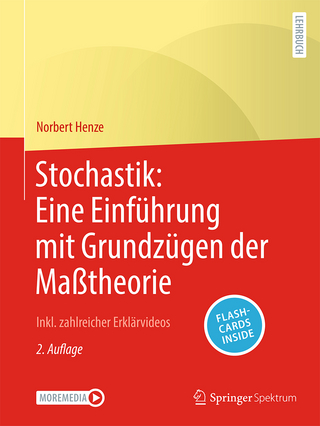
Maximum Entropy and Bayesian Methods
Springer (Verlag)
978-0-7923-3452-1 (ISBN)
This volume records papers given at the fourteenth international maximum entropy conference, held at St John's College Cambridge, England. It seems hard to believe that just thirteen years have passed since the first in the series, held at the University of Wyoming in 1981, and six years have passed since the meeting last took place here in Cambridge. So much has happened. There are two major themes at these meetings, inference and physics. The inference work uses the confluence of Bayesian and maximum entropy ideas to develop and explore a wide range of scientific applications, mostly concerning data analysis in one form or another. The physics work uses maximum entropy ideas to explore the thermodynamic world of macroscopic phenomena. Of the two, physics has the deeper historical roots, and much of the inspiration behind the inference work derives from physics. Yet it is no accident that most of the papers at these meetings are on the inference side. To develop new physics, one must use one's brains alone. To develop inference, computers are used as well, so that the stunning advances in computational power render the field open to rapid advance. Indeed, we have seen a revolution. In the larger world of statistics beyond the maximum entropy movement as such, there is now an explosion of work in Bayesian methods, as the inherent superiority of a defensible and consistent logical structure becomes increasingly apparent in practice.
Applications.- Flow and diffusion images from Bayesian spectral analysis of motion-encoded NMR data.- Bayesian estimation of MR images from incomplete raw data.- Quantified maximum entropy and biological EPR spectra.- The vital importance of prior information for the decomposition of ion scattering spectroscopy data.- Bayesian consideration of the tomography problem.- Using MaxEnt to determine nuclear level densities.- A fresh look at model selection in inverse scattering.- The maximum entropy method in small-angle scattering.- Maximum entropy multi-resolution EM tomography by adaptive subdivision.- High resolution image construction from IRAS survey — parallelization and artifact suppression.- Maximum entropy performance analysis of spread-spectrum multiple-access communications.- Noise analysis in optical fibre sensing: A study using the maximum entropy method.- Algorithms.- AutoClass — a Bayesian approach to classification.- Evolution reviews of BayesCalc, a MATHEMATICA package for doing Bayesian calculations.- Bayesian inference for basis function selection in nonlinear system identification using genetic algorithms.- The meaning of the word “Probability”.- The hard truth.- Are the samples doped — If so, how much?.- Confidence intervals from one observation.- Hypothesis refinement.- Bayesian density estimation.- Scale-invariant Markov models for Bayesian inversion of linear inverse problems.- Foundations: Indifference, independence and MaxEnt.- The maximum entropy on the mean method, noise and sensitivity.- The maximum entropy algorithm applied to the two-dimensional random packing problem.- Neural Networks.- Bayesian comparison of models for images.- Interpolation models with multiple hyperparameters.- Density networks and their application to proteinmodelling.- The cluster expansion: A hierarchical density model.- The partitioned mixture distribution: Multiple overlapping density models.- Physics.- Generating functional for the BBGKY hierarchy and the N-identical-body problem.- Entropies for continua: Fluids and magnetofluids.- A logical foundation for real thermodynamics.
| Reihe/Serie | Fundamental Theories of Physics ; 70 |
|---|---|
| Zusatzinfo | XI, 323 p. |
| Verlagsort | Dordrecht |
| Sprache | englisch |
| Maße | 155 x 235 mm |
| Themenwelt | Mathematik / Informatik ► Mathematik ► Wahrscheinlichkeit / Kombinatorik |
| Naturwissenschaften ► Physik / Astronomie ► Thermodynamik | |
| ISBN-10 | 0-7923-3452-3 / 0792334523 |
| ISBN-13 | 978-0-7923-3452-1 / 9780792334521 |
| Zustand | Neuware |
| Haben Sie eine Frage zum Produkt? |
aus dem Bereich


